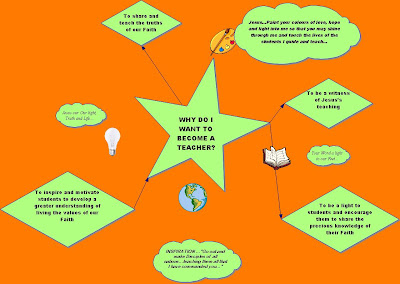
Graphic organisers such as this mind map created in Inspiration supports students to visually structure and better understand a flow of ideas and their possible connections. The mind map I have attached is a personal reflection on why I want to become a teacher?
This ICT appeals to the following learning styles, as presented in Gardner’s theory of Multiple Intelligences:
Linguistic: these learners are attended to by the written text on the mind map
Visual/Spatial: these learners are attended to by the visual illustration of meaningful ideas, thoughts, words and pictures incorporated and interrelated with one another
Interpersonal: these learners are attended to when graphic organisers are constructed and discussed in a collaborative groups or when they are made individually and then considered in a group
Intrapersonal: these learners are attended to when they in their own time examine their personal ideas and reflections through a graphic organiser. (Smith, 2002)
Graphic organisers can be applied as a good cognitive tool within the social learning environment, as they visually stimulate students to dynamically extend their own thoughts and recreate connections between their prior knowledge and acquired knowledge. (Hein, 1991) Specifically, mind maps can be implemented in the classroom to visually depict a reflection of ideas relating to a particular question or issue. This great cognitive tool can also be effective for essay planning in a classroom setting and/or in giving the students an illustrative overview of important concepts covered in a topic area.
No comments:
Post a Comment